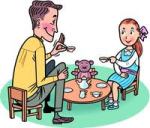What is respect?
Being respected means being valued as a worthwhile human being. It is being treated with dignity regardless of human differences such as age, gender, race and even knowledge and skill.
There are two parts to mutual respect:
- Mutuality is a two-way street (I respect you and you respect me.). For that to happened we must each also respect ourselves.
- Equality is the basis for mutual respect. Equality here does not mean sameness but in the fact that we are human beings, belonging to the human family. We all need to be treated with dignity and respect. It means we have value or personal worth simply because we are human beings.
How mutual respect works in an adult/child relationship:
Many of us were raised with the idea that children must respect adults, while children were often treated with disrespect. We were taught to obey and this was enforced with reward and punishment. Children were controlled by the adults in their lives. Under this system, children learned to have others think for them, to avoid mistakes and to be submissive to an external authority.
Mutual respect between adults and children requires us to shift out beliefs and techniques of parenting. While the roles of parent and child are different, the individuals involved are of equal value as human beings. When parents are providing for, nurturing and teaching children in a non-punitive way, children come to believe that they are worthwhile, that they have abilities and that others believe in them and trust them. Parents can most effectively help children to learn to become independent, contributing individuals with strong internal motivation by doing the following:
- Encouraging and valuing children’s contributions, ideas and efforts.
- Saying “Thank you for helping/sharing. I appreciate it.”
- Accepting and acknowledging children’s feelings as valid, legitimate and real.
- Saying “You’re really sad that you can’t play longer at your friend’s house.”
- Accepting mistakes as opportunities to learn.
- Saying “What did you learn from this?” – Also see last point.
- Finding opportunities for children to makes choices and decisions.
- Give opportunities to make age appropriate choices early.
- Giving assistance in, and opportunity for, critical thinking and problem solving.
- Working trough problems with your child initially to teach the skills and then letting your child do it on his/her own once s/he has the skills
- Sharing affection and fun with children.
- Lots of hugs and playing with your children.
- Remember that example is the most powerful teacher.
- No comment needed here!
Adapted from an article by E. Quiring and B. Johnson.











